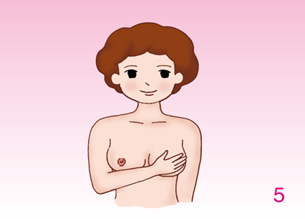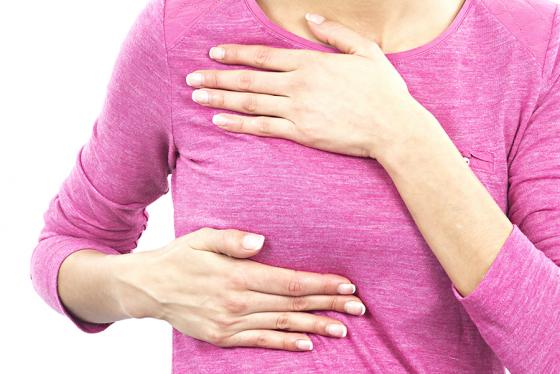22 Apr 2025 - Service Adjustment of FPAHK Yuen Long Birth Control Clinic (G/F) and Yuen Long FPAHK Anita Mui Health Centre (1/F) from 12 May 2025 (Monday)
31 Dec 2024 - Opening Hours of FPA Birth Control Clinics from January to December, 2025
Common Breast Problems
Many women are alarmed and think of breast cancer when they discover any discomfort in their breasts. In fact most breast problems in women of reproductive age are caused by physiological changes and are not cancer. Common breast problems include breast lumps, breast pain and nipple discharge.
1. Breast Lumps
Most breast lumps are benign, e.g. fibroadenomas and cysts. They will not change into breast cancer.
Fibroadenomas
Fibroadenomas are solid tissue growths. Most of these lumps do not cause symptoms and are detected by the woman herself or her doctor during breast examination. A small sample of tissue (biopsy) can be taken from the breast lump using a fine needle for further examination. If the tissue and cells are not cancerous, the lesion can be observed. Surgery may be required if the fibroadenoma is large or growing in size. Women with fibroadenoma are advised to note any changes in the breast lump.
Cysts
Cysts are sacs filled with fluid secretions from breast glands. They often vary in size during the menstrual cycle, becoming smaller after menses. They are not cancer and surgery is not required. Imaging study is needed to differentiate simple cysts from complex cysts. Complex cysts need biopsy to confirm the tissue type, while simple cysts do not need further surgical intervention. If the simple cyst causes pain, it can be aspirated with a fine needle. The cyst will disappear after this procedure but may appear again, so regular self examination is advised.
2. Breast pain
Most women experience some degree of cyclical pain in the week before menses. This is a physiological condition caused by hormone level changes and no treatment is required. Simple painkillers can be used if necessary.
Other possible causes of breast pain include: poorly-fitted bra, excessive exercise or physical trauma. Such pain is non-cyclical and often localized. It usually resolves without treatment or with simple painkillers.
Fibroadenosis
Fibroadenosis is a common condition characterized with diffuse pain, swelling and lumpiness in both breasts. The symptoms are usually more severe before menses and subside when menstruation ends. No treatment is required except simple painkillers for symptomatic relief if necessary.
Surgical conditions of the breast e.g. mastitis, breast abscess and rarely breast cancer can be causes of breast pain. Please consult your doctor to ascertain the cause of your breast pain.
3. Nipple Discharge
Clear or milky discharge is related to over-stimulation of the breast glands. It can occur after recent childbirth. Tumour of the pituitary gland in the brain can secrete the hormone prolactin which stimulates nipple discharge. Certain medicines such as some oral contraceptive pills, psychiatric drugs and blood pressure lowering drugs may also cause nipple discharge, which will stop when the medicine is discontinued.
Purulent discharge together with redness and pain can be caused by infection of the breast glands (mastitis). Blood-stained discharge should be promptly investigated to exclude cancer.

Be Breast Aware
Regular breast self-examination can help to raise women’s awareness of the changes in her breasts. In fact most breast lumps are detected by women themselves during self-examination. The best time to examine yourself is when the breasts are not painful or swollen, such as after menstruation. Women after the menopause can do it anytime. Visit your doctor promptly if you find a lump.
Breast Imaging
Our doctor will recommend further imaging based on your age, symptoms, clinical findings and risks for breast cancer.
Ultrasound examination of the breasts is safe, painless and useful in evaluating breast lumps. Women of all ages are suitable for this examination.
Mammogram is a special X-ray of the breasts suitable for women over 40 years old.

Breast Cancer
If detected early, over 80% of breast cancers can be cured.
Who are at Higher Risk of Breast Cancer?
- Women whose close relatives suffered from breast cancer
- Women who have had cancer in one breast
What are the Signs and Symptoms of Breast Cancer?
- Breast : any lump(s), change in breast size and shape, dimpling or puckering of the skin
- Nipple : retraction of the nipple, secretion or bleeding
- Armpit : swelling of the lymph glands in the armpit
Breast Self-Examination
This should be performed regularly. If you still menstruate, examine your breasts 2-3 days after menstrual period. If you no longer menstruate, examine your breasts regularly.
Method of examination:
- Stand in front of a mirror, raise your arms over your head and look for any changes in your breasts.
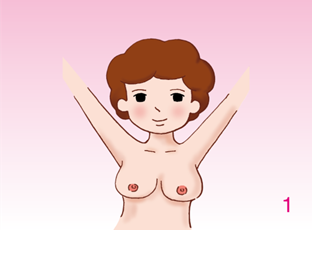
- Press the pads of your three middle fingers gently over the inner side of your breast in circling movements to check for any unusual lumps.
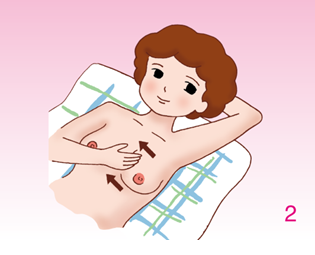
- Repeat the same on the outer side of your breast.
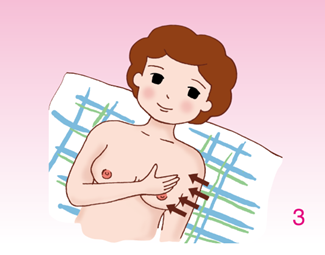
- Examine the area between the breast and the armpit for any unusual lumps.
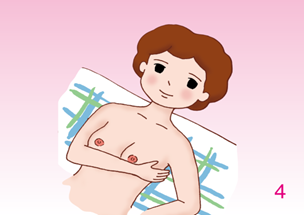
- Gently squeeze the nipple and look for any discharge.
